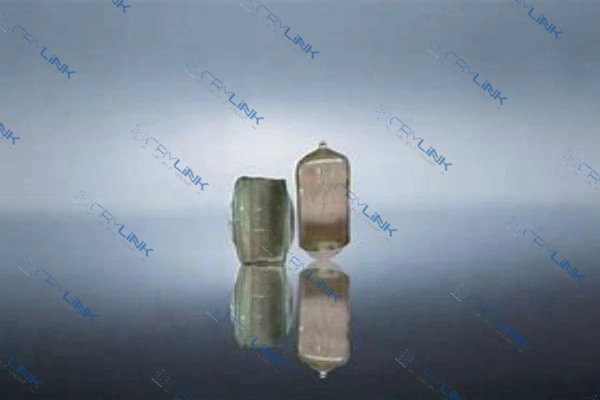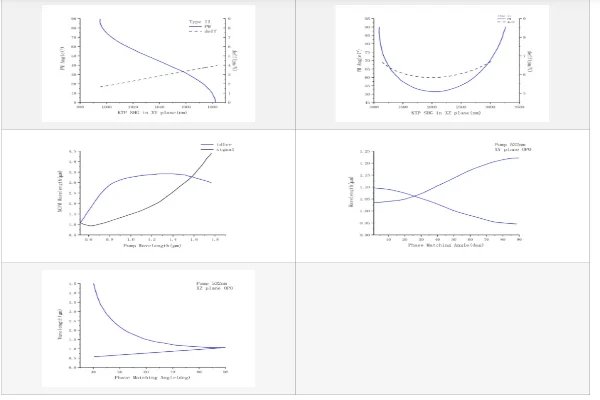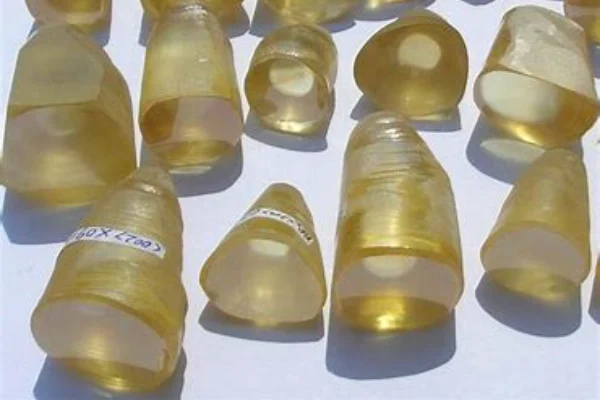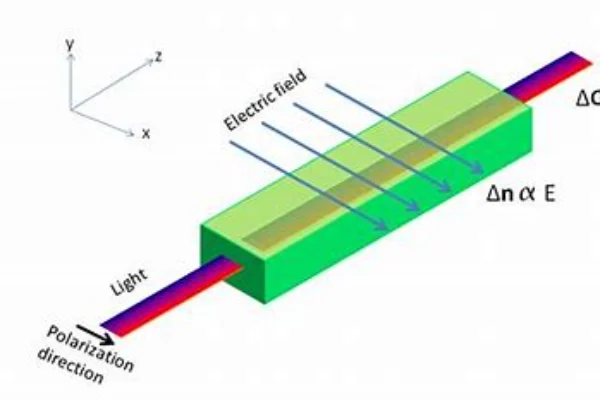Introduction: An Insight into Electro-Optic Modulators
In the cutting-edge world of telecommunications, electro-optic modulators are the linchpin for ultra-fast and efficient data transmission. These vital components, capable of modifying light properties under the influence of an electric field, have found wide-ranging applications, from laser communication to optical signal processing. The heart of these devices, the crystal materials, holds significant sway over their performance, presenting a spectrum of opportunities and challenges.
Unraveling the Mysteries of the Electro-Optic Effect
To fully appreciate the diverse array of crystal materials, one must first comprehend the underpinning phenomenon – the electro-optic effect. This principle illustrates the change in refractive index of a substance subjected to an electric field. The responsiveness of a material to the electric field, expressed as the electro-optic coefficient, is a cornerstone in determining the performance of electro-optic modulators.

Lithium Niobate (LiNbO3): The High-Speed Performer
Lithium niobate (LiNbO3) has long held the spotlight in the field of electro-optic modulators. This crystalline material garners attention owing to its exceptional electro-optic coefficients, a trait that enables it to offer unparalleled high-speed modulation capability. This performance aspect opens up broad prospects in diverse applications, particularly in telecommunications and optical signal processing systems where speed and efficiency are paramount.
Additionally, LiNbO3 boasts a lower dielectric constant. This key property allows for minimal signal distortion during data transmission, ensuring that the integrity and quality of the information remain intact. Furthermore, it is no secret that heat generation can be a significant roadblock in the operation of optical devices. Here again, LiNbO3 shines with its impressive thermal conductivity, effectively dissipating heat and ensuring the modulator’s smooth operation even under demanding conditions.
But like all things in life, LiNbO3 comes with its fair share of drawbacks that may offset its impressive attributes. A notable downside lies in its photorefractive effect. Under high optical powers, LiNbO3 may display undesirable changes in its index of refraction. This effect can lead to issues such as beam distortion or signal degradation, limiting its effectiveness in high-power applications.
Furthermore, LiNbO3’s structural integrity may come into question. The material is known to be susceptible to surface damage and mechanical stress. This vulnerability could potentially impact the longevity and durability of the modulator, especially in environments where the device may be subject to harsh conditions or mechanical shocks. Consequently, while LiNbO3’s attributes are impressive, these considerations must be factored into the decision-making process when selecting the optimal crystal material for an electro-optic modulator.

Potassium Titanyl Phosphate (KTP): The Power Handler
Making its mark in the world of electro-optic modulators is potassium titanyl phosphate (KTP), a crystal material renowned for its durability and non-linear optical properties. Its standing as a material with a high damage threshold makes it well-equipped to handle considerable optical powers, an asset for high-power applications where the robustness of the modulator is critical. This durability doesn’t come at the cost of performance; KTP stands tall in delivering top-notch modulation efficiency, making it an alluring choice for complex optical systems.
A distinguishing trait of KTP is its relatively high electro-optic coefficients. This characteristic ensures that even with reduced applied voltages, the material facilitates efficient modulation. Consequently, KTP proves to be an energy-efficient choice, reducing power consumption while not compromising on performance, an appealing feature in today’s energy-conscious environment.

Despite its sterling qualities, KTP is not without its limitations. A significant challenge arises due to its high absorption coefficient in the infrared region. This trait restricts its use in certain applications, particularly those involving infrared signals. This limitation could potentially rule out KTP as a viable choice for certain telecommunications and optical signal processing applications, where the transmission of infrared signals is integral.
Furthermore, compared to its counterpart, LiNbO3, KTP has a lower thermal conductivity. This implies that the material may struggle to efficiently dissipate heat generated during high-power operation. The resultant heating issues could impact the performance of the electro-optic modulator and even pose potential risks to its durability. This shortcoming necessitates careful consideration and strategic design to circumvent thermal challenges when employing KTP in high-power systems. Despite these challenges, KTP’s robust performance and resilience make it a formidable player in the arena of electro-optic modulators.
-crylink.webp)
Rutile (TiO2): The Resilient Performer
Stepping into the realm of electro-optic modulators is rutile, also known as titanium dioxide (TiO2). This material stands out for its notable refractive properties, offering unique advantages in the manipulation of light waves. Its high refractive index coupled with low absorption in the visible spectrum makes it a valuable choice for various optical applications.
TiO2’s claim to fame extends beyond its optical properties. The material is recognized for its outstanding damage resistance, making it an embodiment of durability and resilience. This characteristic ensures reliable operation over extended periods, a crucial factor in any long-term project or application. Additionally, TiO2 boasts considerable birefringence, a property that paves the way for efficient modulation of polarized light. This can be especially advantageous in telecommunications and optical signal processing systems where the polarization state of the signal can carry additional information.
However, every rose has its thorns, and rutile is no exception. Compared to its counterparts, LiNbO3 and KTP, TiO2 is less effective for phase modulation. This limitation stems from its lower electro-optic coefficients, which means the material requires higher electric fields to achieve the same degree of modulation. Such a requirement can lead to increased power consumption and potentially lower modulation speeds.
In addition, TiO2 exhibits high absorption in the ultraviolet range, which can limit its usability in specific applications. This absorption can cause inefficiencies or damage when used with UV lasers or other UV light sources, thereby narrowing the range of possible applications. Regardless of these challenges, the resilience and unique optical properties of rutile make it a worthy contender in the landscape of electro-optic modulator materials.

Guided by Applications: Choosing the Appropriate Crystal Material
The quest for the ideal crystal material in electro-optic modulators hinges significantly on the specific system requirements and the intended application. As in any other technological field, there is no one-size-fits-all answer; instead, the perfect choice boils down to a delicate balance of several factors that consider both the strengths and weaknesses of the available materials.
For applications that prioritize high-speed modulation, lithium niobate (LiNbO3) often emerges as a top contender. Its outstanding electro-optic coefficients and low dielectric constant enable it to achieve rapid modulation with minimal signal distortion. This makes it an attractive choice for telecommunications and other high-speed data transmission systems where efficiency and speed are of utmost importance.
However, in environments that call for high-power operations, the robustness and resilience of potassium titanyl phosphate (KTP) may give it an edge. KTP’s impressive damage threshold allows it to withstand considerable optical powers while still maintaining top-notch performance. Hence, it can prove invaluable in industrial or military applications where the modulator might be subject to intense optical powers.
When dealing with tasks involving polarized light, rutile or titanium dioxide (TiO2), with its vast birefringence, might prove to be the most suitable choice. Its ability to efficiently modulate polarized light can open up new avenues in applications such as advanced optical communication systems, optical data storage, and quantum computing.
Ultimately, the choice of crystal material for an electro-optic modulator isn’t about seeking the best in an absolute sense but rather finding the one that fits best within the parameters of a given application. By aligning the selection process with the specific system requirements and intended use cases, one can harness the full potential of these remarkable materials in electro-optic modulation.

Looking Ahead: The Future of Electro-Optic Modulators
As we peer into the future, the landscape of electro-optic modulators appears rich with potential and ripe for innovation. With an ever-increasing demand for improved performance, versatility, and efficiency, researchers and scientists globally are tirelessly striving to push the boundaries of what’s possible.
One exciting avenue of exploration is the doping of crystal materials. By introducing impurities into the crystal lattice, it’s possible to significantly alter the material’s electro-optic properties, potentially unlocking new capabilities or improving existing characteristics such as the electro-optic coefficient or damage threshold.
Additionally, advancements in the design and fabrication of waveguides present new opportunities. By carefully controlling the propagation of light through the modulator, it’s possible to achieve more efficient or more precise modulation, increasing the device’s overall performance.
Moreover, cutting-edge structures like photonic crystals are paving the way for a new era of electro-optic modulators. These materials, whose properties emerge from their intricate structural patterns rather than their chemical composition, could allow for an unprecedented level of control over light, leading to transformative breakthroughs in the field of electro-optic modulation.
As we navigate this exciting frontier, one thing is clear: the future of electro-optic modulators is bright, and we eagerly anticipate the innovations that lie just over the horizon.
Conclusion: Mastering Electro-Optic Modulators
To leverage the immense power of electro-optic modulators, a comprehensive and comparative understanding of different crystal materials is indispensable. Recognizing the unique strengths and limitations of materials such as LiNbO3, KTP, and TiO2 allows users to align modulators to their system requirements, thereby unlocking unprecedented potential in light-speed communication and beyond.
Frequently Asked Questions (FAQs)
- Q1: What makes electro-optic modulators crucial in high-speed communication systems?
- A1: Electro-optic modulators are essential in high-speed communication systems as they can modify the properties of light, including phase, polarization, and intensity, based on an applied electric field. By doing so, they convert electronic signals into optical signals, facilitating ultra-fast and efficient data transmission.
- Q2: What parameters should one consider while selecting a crystal material for an electro-optic modulator?
- A2: The selection of crystal materials for an electro-optic modulator is largely dependent on factors such as the electro-optic coefficients (which determine the modulation efficiency), thermal conductivity (for heat dissipation), mechanical robustness (for durability), and specific absorption coefficients (which can affect the transmission properties).
- Q3: What future advancements can we expect in the field of electro-optic modulators?
- A3: Future advancements in the field of electro-optic modulators may involve the development of new materials with improved electro-optic coefficients, better thermal properties, and enhanced durability. Furthermore, innovations may encompass novel fabrication techniques, such as the integration of waveguides or photonic crystals, to increase modulation efficiency and system performance.
- Q4: Why is lithium niobate a popular choice for electro-optic modulators?
- A4: Lithium niobate (LiNbO3) is a popular choice for electro-optic modulators due to its outstanding electro-optic coefficients, which enable high-speed modulation. Moreover, its low dielectric constant minimizes signal distortion, and good thermal conductivity allows for efficient heat dissipation, making it suitable for various applications.
- Q5: What challenges does rutile present when used in electro-optic modulators?
- A5: While rutile (TiO2) offers robust refractive properties and high damage resistance, it presents certain challenges. Its electro-optic coefficients are lower than materials like LiNbO3 and KTP, making it less effective for phase modulation. Furthermore, its high absorption in the ultraviolet range could restrict its use in specific applications.

Frank
Frank graduated from the University of Shanghai for Science and Technology, majoring in optics. As a technical engineer at Crylink Company, he deeply understands crystal materials and laser components.
Related Video(s) with this Article
Related Product(s) with this Article
Related Application(s) with this Article
